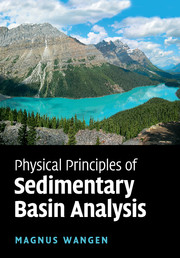Book contents
- Frontmatter
- Contents
- Preface
- Acknowledgments
- 1 Preliminaries
- 2 Properties of porous media
- 3 Linear elasticity and continuum mechanics
- 4 Compressibility of rocks and sediments
- 5 Burial histories
- 6 Heat flow
- 7 Subsidence
- 8 Rheology: fracture and flow
- 9 Flexure of the lithosphere
- 10 Gravity and gravity anomalies
- 11 Quartz cementation of sandstones
- 12 Overpressure and compaction: exact solutions
- 13 Fluid flow: basic equations
- 14 Fluid flow: basic equations
- 15 Wells
- Appendix: Fourier series, the discrete Fourier transform and the fast Fourier transform
- References
- Index
7 - Subsidence
Published online by Cambridge University Press: 07 May 2010
- Frontmatter
- Contents
- Preface
- Acknowledgments
- 1 Preliminaries
- 2 Properties of porous media
- 3 Linear elasticity and continuum mechanics
- 4 Compressibility of rocks and sediments
- 5 Burial histories
- 6 Heat flow
- 7 Subsidence
- 8 Rheology: fracture and flow
- 9 Flexure of the lithosphere
- 10 Gravity and gravity anomalies
- 11 Quartz cementation of sandstones
- 12 Overpressure and compaction: exact solutions
- 13 Fluid flow: basic equations
- 14 Fluid flow: basic equations
- 15 Wells
- Appendix: Fourier series, the discrete Fourier transform and the fast Fourier transform
- References
- Index
Summary
This chapter deals with the mechanisms responsible for subsidence and basin formation. Before we look at these mechanisms we will recapture a little bit of the plate tectonic setting of sedimentary basins.
The surface of the Earth is made of two types of rigid plates – those beneath the oceans and those beneath the continents. The oceanic plates are produced at mid-ocean ridges and are consumed by subduction beneath other plates at ocean trenches. The continents are placed on stable plates that are much older than the oceanic plates. Plate tectonics is the theory of these plates and their movements. The rigid part of the Earth's interior is called the lithosphere and the lower boundary for the lithosphere is given by an isotherm (∼1300 °C) in the mantle. The mantle below this isotherm is called the asthenosphere, and it is sufficiently hot to behave like a fluid on a geological time scale. The lithosphere is viewed as a body that floats on a fluid-like mantle asthenosphere, and it behaves like a rigid body that can transmit stress over large distances. The forces that push a plate away from the ridge and pull the plate down into the Earth at an ocean trench are carried through the plate. The lithosphere is divided into the crust and the lithospheric mantle by the boundary named the Moho after the Croatian seismologist Mohorovičić who discovered the discontinuity in 1909. The Moho is a material contrast between a crust that is less dense than the lithospheric mantle below. The crust of the continental lithosphere is older, less dense, more heterogeneous and thicker than the oceanic crust (see Figure 7.1).
- Type
- Chapter
- Information
- Physical Principles of Sedimentary Basin Analysis , pp. 194 - 259Publisher: Cambridge University PressPrint publication year: 2010



